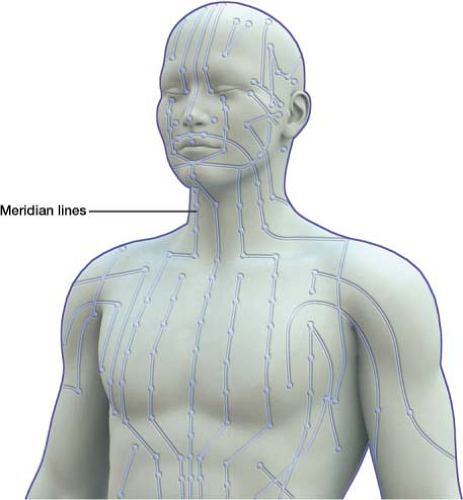Complementary Treatments
Complementary medicine is defined as medical interventions not routinely taught at American medical schools. Although there have been great strides in conventional pain management over the past two decades, there are significant inadequacies, causing many patients to seek other options for controlling their pain. This chapter describes complementary treatments that do not involve physical therapy, oral medications, injections, or surgical procedures.
Acupuncture
Acupuncture is a form of traditional Chinese medicine established sometime between 4,000 and 5,000 years ago (“acus” means needle and “puncture” means penetration). According to traditional Chinese medicine, our body is balanced with a system of properly distributed energy called “gi” (pronounced chee). The flow of life energy – gi energy – circulates along our body in lines called “meridians” (Fig. 33-1). The gi energy that
exists in the meridian lines is balanced, as is the energy of nature, according to the Chinese yin yang principle. An imbalance in energy is thought to be the cause of illness. Acupuncture aims at establishing and maintaining appropriate flow through these meridians.
exists in the meridian lines is balanced, as is the energy of nature, according to the Chinese yin yang principle. An imbalance in energy is thought to be the cause of illness. Acupuncture aims at establishing and maintaining appropriate flow through these meridians.
In the United States, more than 3,000 physicians use acupuncture to treat a variety of conditions, including headache, musculoskeletal pain, nausea, and addiction. Patients usually undergo acupuncture sessions two to three times per week for a period of at least 3 to 6 weeks. When performed by well-trained practitioners, acupuncture carries minimal risk.
There are approximately 360 classic acupuncture points. Interestingly, greater than 70% of these points correlate with myofascial trigger points. Practitioners place the acupuncture needles along different meridian lines. The selection of needle placement depends on the underlying pathology. Recent Western studies suggest that acupuncture may have multiple effects on the body. Research has shown that acupuncture releases endogenous opioids – the same ones that are released with running, known to cause “runner’s high.” In one study, naloxone, an opioid antagonist, partially reversed the analgesia caused by acupuncture. Acupuncture may also activate large myelinated nerve fibers. According to the gate control theory, the stimulation of large myelinated fibers causes inhibitory effects on pain-transmitting unmyelinated fibers. In addition, acupuncture may lead to alterations in the hypothalamus, modifying the limbic system response to pain.
Stay updated, free articles. Join our Telegram channel

Full access? Get Clinical Tree









